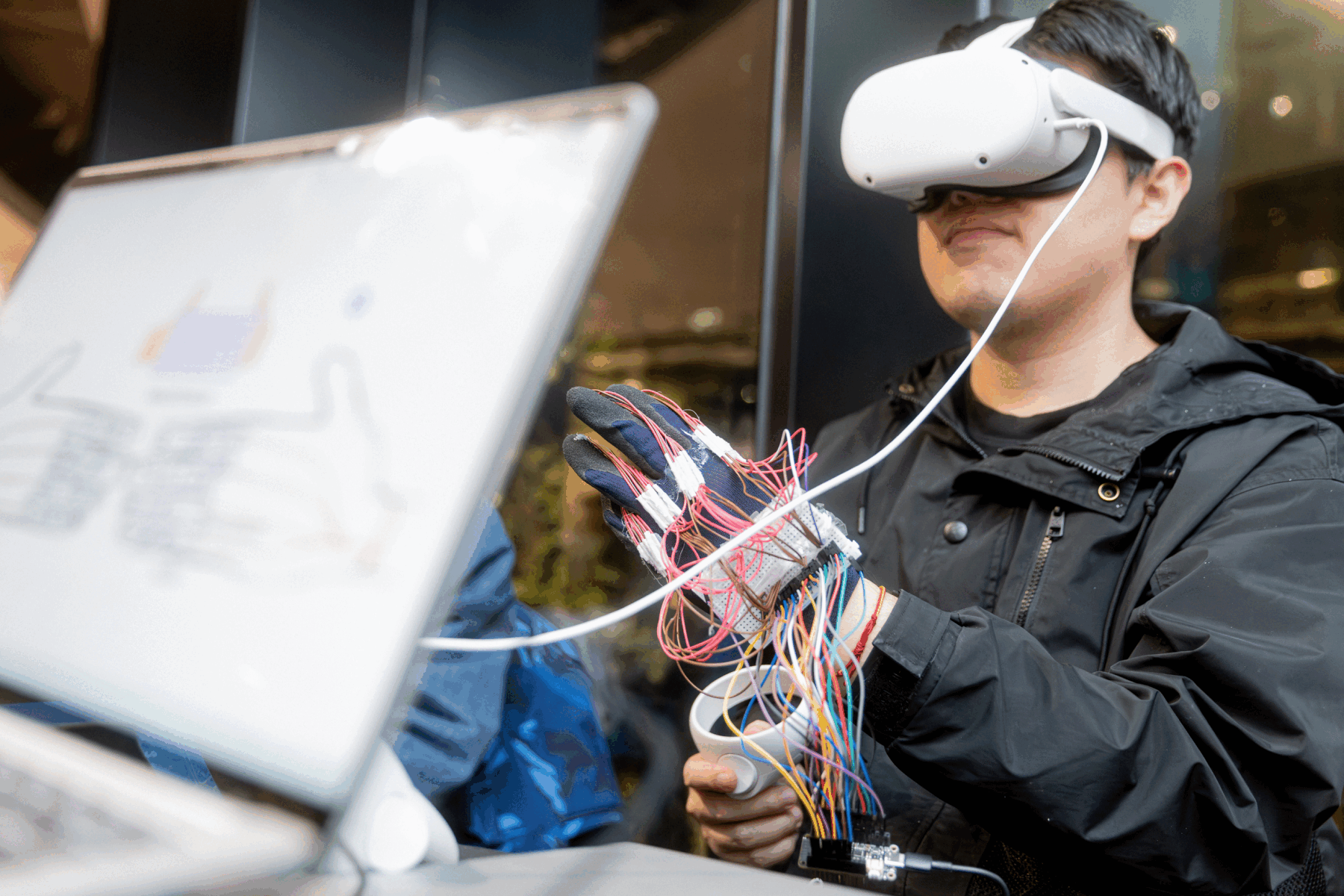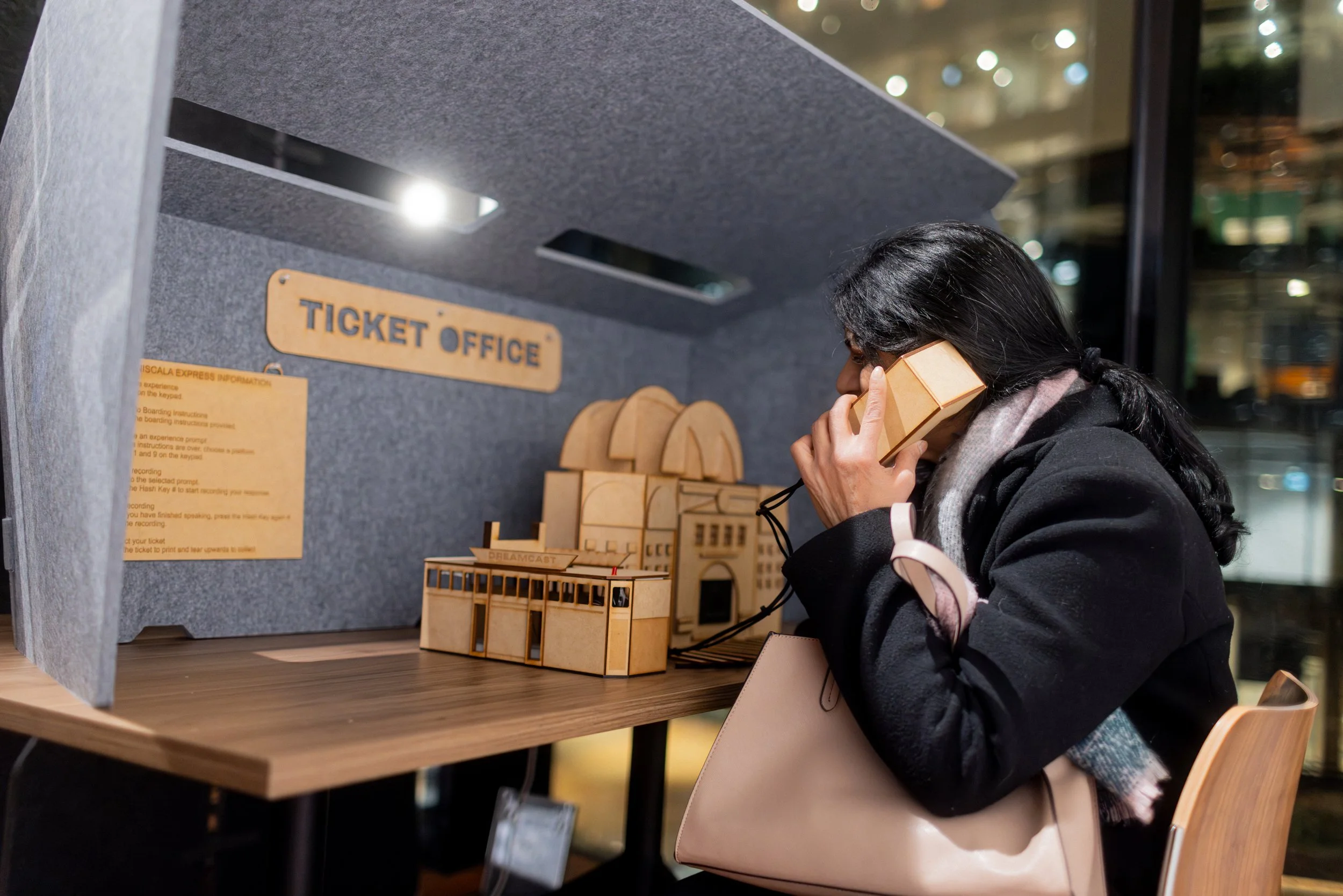Cybernetics Futures Showcase
~*~*~
23RD MAY 2025
~*~*~
Cybernetics Futures Showcase ~*~*~ 23RD MAY 2025 ~*~*~
Bringing the energy of the 1980s science fairs, this exhibition features over 50 science-fiction inspired working prototypes that examine our future relationship with technology.
From board games and XR experiences to weird and wonderful poetic computation objects, students have come together to reimagine both existing systems and speculative new ones revealing the future worlds they’d like to see and/or explore.
This showcase is part of two subjects, Designing Novel Interactions (led by Mel Huang Buntine and Dr Adelaide Genay) and Game Design (led by Prof Martin Gibbs) at the School of Computing and Information Systems, Faculty of Engineering and Information Technology, The University of Melbourne.
This event is supported by School of Computing and Information Systems | The University of Melbourne, Science Gallery Melbourne, Telstra Creator Space, Melbourne Connect and the Computing and Information Systems Students Association (CISSA).
23 May 2025, 11AM — 5PM
INTERACTIVE PROTOTYPES
GROUP NAME
Linggar ANDARU
Keanan KHOR
Gabriella Sekar SHADA
Benjamin WALD
-
NISCALA explores the interaction between human emotions, memories and interactive technologies. Our focus is to find an equilibrium between the emotional connection humans have with technology, as well as provide users with a memory to take home with them. By reimagining the phone, and designing our installation based on transport, we have created 9 different prompts for people to interact with. NISCALA transports you through time and encourages participants to record their answers through the phone and allow our prototype to print off a ticket with their response as a memory. This is done through a microphone and speaker that converts the speech to text and sends the text file to a thermal printer for the participants to either take home their memory or pin it up on NISCALA station.
MDF laser cut, Thermal printer, Adafruit Feather ESP32 V2 microcontroller, OpenAI Whisper (speech-to-text) module, USB Microphone, USB Speaker, Red LED, 12 keys keypad, Desk Hood, Partitiion board (exhibition design)
Integers
Thanh Hoang NGUYEN
Acalapati PRIYATAMA
Sakdiphat TANPHIPHATARI
-
Our prototype showcases a form of touch-based interaction with plants, when touching the plant, you'll be able to play musical notes and even select the types of musical instruments that you want to play with. The plant is connected to a touch shield that's connected to an Arudino board, acting as a MIDI controller. Then in the software side of things, the output of the values produced by the plant when touched is converted with a Python script to musical notes that plays through a DAW (Digital Audio Workstation), specifically on FL Studio. Aside from that, the plant is surrounding with LED lights to show your interactions with it.
Arduino Leonardo, Adafruit 12 x Capacitive Touch Shield for Arduino , MPR121, Solderer, Feather Stackable Header Kit, Jumper Wire 20cm Ribbon, Alligator Clip Cable, Diffused RGB 5mm LED, 3D Printed Geometric Plant Pot (Designed using Fusion 360), 3D Printed LED holder (Designed using Fusion 360), Laptop (for speakers and DAW), FL Studio
Metres
Andrea BREJCHA
Wenzheng DU
Hiu Wah LAM
Stuti PANDE
-
Gossiping Birds is a creative and humorous reinterpretation of the bird song.
Birds sing a variable song resembling realistic calls in response to viewers interaction. A computer generates a script or “translation” of the conversation occurring between the birds, which alters based on the detection of human presence. The idea is that the birds are gossiping between themselves and are being exposed by the live translation.
Laptop, Adafruit Feather ESP32 V2, Ultrasonic sensors, Servo motors, 3D printed bird models, Timber ledge, Laser-cut internal supports
GAME DESIGN
Dreamcast
Linggar ANDARU
Keanan KHOR
Gabriella Sekar SHADA
Benjamin WALD
-
NISCALA explores the interaction between human emotions, memories and interactive technologies. Our focus is to find an equilibrium between the emotional connection humans have with technology, as well as provide users with a memory to take home with them. By reimagining the phone, and designing our installation based on transport, we have created 9 different prompts for people to interact with. NISCALA transports you through time and encourages participants to record their answers through the phone and allow our prototype to print off a ticket with their response as a memory. This is done through a microphone and speaker that converts the speech to text and sends the text file to a thermal printer for the participants to either take home their memory or pin it up on NISCALA station.
MDF laser cut, Thermal printer, Adafruit Feather ESP32 V2 microcontroller, OpenAI Whisper (speech-to-text) module, USB Microphone, USB Speaker, Red LED, 12 keys keypad, Desk Hood, Partitiion board (exhibition design)
Integers
Thanh Hoang NGUYEN
Acalapati PRIYATAMA
Sakdiphat TANPHIPHATARI
-
Our prototype showcases a form of touch-based interaction with plants, when touching the plant, you'll be able to play musical notes and even select the types of musical instruments that you want to play with. The plant is connected to a touch shield that's connected to an Arudino board, acting as a MIDI controller. Then in the software side of things, the output of the values produced by the plant when touched is converted with a Python script to musical notes that plays through a DAW (Digital Audio Workstation), specifically on FL Studio. Aside from that, the plant is surrounding with LED lights to show your interactions with it.
Arduino Leonardo, Adafruit 12 x Capacitive Touch Shield for Arduino , MPR121, Solderer, Feather Stackable Header Kit, Jumper Wire 20cm Ribbon, Alligator Clip Cable, Diffused RGB 5mm LED, 3D Printed Geometric Plant Pot (Designed using Fusion 360), 3D Printed LED holder (Designed using Fusion 360), Laptop (for speakers and DAW), FL Studio
Metres
Andrea BREJCHA
Wenzheng DU
Hiu Wah LAM
Stuti PANDE
-
Gossiping Birds is a creative and humorous reinterpretation of the bird song.
Birds sing a variable song resembling realistic calls in response to viewers interaction. A computer generates a script or “translation” of the conversation occurring between the birds, which alters based on the detection of human presence. The idea is that the birds are gossiping between themselves and are being exposed by the live translation.
Laptop, Adafruit Feather ESP32 V2, Ultrasonic sensors, Servo motors, 3D printed bird models, Timber ledge, Laser-cut internal supports
Designing Novel Interactions (INFO90003)
Presented as part of NGV’s Melbourne Design Week 2025
School of Computing and Information Systems,
Faculty of Engineering and Information Technology, The University of Melbourne
Mel Huang is an interactive designer and developer for the arts and culture sectors collaborating with institutions such as Powerhouse Museum, Science Gallery, NGV, Art Gallery NSW, Dark Mofo and The Australian Ballet. She is currently an Academic Fellow, Art and Computer Science and Lecturer at the University of Melbourne.
Spanning works across data visualisation, interactive design and live performance, Mel is passionate about the creative applications of technology in the arts and an advocate of multidisciplinary practices.
Mel is part of the Designing Novel Interactions teaching team.
Dr Adelaide Genay
Adelaide is a researcher and lecturer in Computer Graphics and Visualisation at the University of Melbourne. Her research focuses on Human-Computer Interactions with a focus on Augmented Reality and Virtual Reality technologies. Her career started as a Technical Leader for a French start-up company (Co-Idea) and was followed by postdocs at the University of Melbourne and Monash University. Before that, she did her PhD at Inria in Bordeaux, France. Over weekends, she escapes the city to enjoy her favorite hobbies: sailing, diving, 4WDing, and camping.
Adelaide is part of the Designing Novel Interactions teaching team.
Prof Martin Gibbs
Martin Gibbs is a Professor of Human-Computer Interaction in the School of Computing and Information Systems at the University of Melbourne. His research interests lie at the intersection of Science Technology Studies (STS) and Human Computer Interaction (HCI). His recent research has focused on the study of death, ritualisation and interactive technologies with an interest in how game designers and players use games to commemorate and memorialize the dead. He is an author of the books Death and Digital Media (2018, Routledge) and Digital Domesticities (2020, Oxford).
Martin is part of the Games Design teaching team.
Muhammad Bilal
Muhammad Bilal is pursuing his PhD at the University of Melbourne, specializing in robotics and human-robot interaction. He holds B.Sc. (Hons) and M.Sc. degrees in Mechatronics Engineering from the University of Engineering and Technology in Lahore, Pakistan. Previously, he worked as a research assistant and later as Team Lead at the National Center of Robotics and Automation in Pakistan.
Muhammad is part of the Designing Novel Interactions teaching team.
Tom Byers
Tom Byers is a PhD candidate in the Faculty of Engineering & IT at the University of Melbourne, researching time and temporality in user experience and design. His published work explores content creation, post-gaming perspectives, and Australian representation on Wikipedia. He tutors and supports video game and technology-focused subjects at the University of Melbourne. He has worked with the Centre for Wellbeing Science to embed positive learning outcomes in large-scale games and is currently examining experiences of racism via a video game probe with the Faculty of Arts.
Tom is part of the Games Design teaching team.
Jian Zhang
Jian Zhang is a PhD student in human-computer interaction at the University of Melbourne. His current research topic is haptic feedback in VR/AR. He has Master's degree in Artificial Intelligence from Tokyo Institute of Technology in Tokyo, Japan and Bachelor's degree in Mechanical Engineering from Shanghai Jiao Tong University in Shanghai, China, where he worked in robotics and robot-assisted rehabilitation.
Jian is part of the Designing Novel Interactions teaching team.
Jiayi Wu
Jiayi Wu is a UX/UI developer who completed her Master of Software Engineering with specialisation in HCI at the University of Melbourne in 2024. She has expertise in the design and development of visual interfaces employing Unity, ranging from computer games to extended reality (XR) apps for medical simulation.
Jiayi is part of the Designing Novel Interactions teaching team.
Dr Antony Chacon
Antony is the current IxT and UX Labs Manager in the HCI Group at the University of Melbourne. His expertise spans haptic devices, PCB design, electronics prototyping, digital fabrication, soft robotics, XR development, and HCI education. He earned his PhD in Electrical Engineering and Information Systems from the University of Tokyo, Japan where he researched gesture recognition using ultra-thin wearable sensors. He also holds a Master of Engineering in Mechatronics from the University of Melbourne.
Antony is part of the Designing Novel Interactions teaching team.



